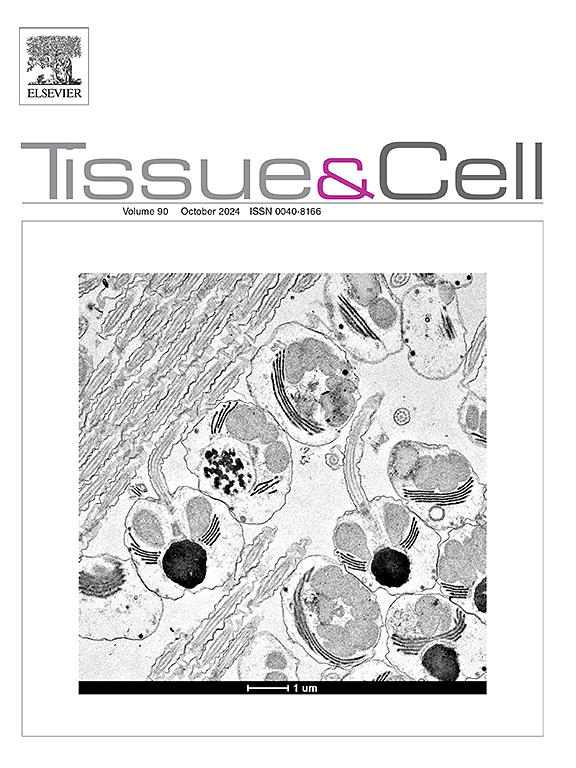Construction of a 3D trophoblast model and validation by triiodothyronine (T3) treatment
IF 2.7
4区 生物学
Q1 ANATOMY & MORPHOLOGY
引用次数: 0
Abstract
During gestation, insufficient triiodothyronine hormone (T3) can lead to failures in trophoblastic activity or induce defects in fetal epigenetic mechanisms. As a consequence, multiple hormones become unbalanced, which can trigger different negative outcomes in the offspring. This study aims to propose the construction of a 3D trophoblast model, validated with different levels of thyroid hormone treatment. Different concentrations of T3, 1, 10 and 100 nM, were employed for 24, 48 and 72 h, corresponding to sub-physiological, physiological and supraphysiological concentrations, respectively, to investigate the effects on human chorionic gonadotropin (hCG), Lactate Dehydrogenase (LDH), and MTT levels in the 3D model. The generated 3D trophoblast model responded differently to the T3 concentrations: although no effect was observed regarding cell viability (MTT assay), there was an increase in cytotoxicity in the group treated with the highest concentration (100 nM; LDH assay) after 24 h. In addition, in the concentration-response curve of hCG, while a natural progressive increase in hCG is observed in control group, there was a clear reduction of hCG in the models treated with 1 nM and 100 nM T3; the 10 nM-treated group demonstrated no difference to control. The proposed 3D trophoblastic placental model was successfully established and validated. Utilizing this model, it was demonstrated that adequate concentrations of T3 are essential for the accurate prediction of cellular function and the prevention of cytotoxic effects. These findings underscore the critical importance of maintaining physiological levels of T3 during pregnancy to support appropriate secretion of hCG.
三维滋养细胞模型的构建及三碘甲状腺原氨酸(T3)处理的验证
在妊娠期间,三碘甲状腺原氨酸激素(T3)不足可导致滋养层活性的失败或诱发胎儿表观遗传机制的缺陷。因此,多种激素变得不平衡,这可能会对后代产生不同的负面影响。本研究旨在构建一个三维滋养细胞模型,并通过不同水平的甲状腺激素治疗进行验证。不同浓度的T3、1、10和100 nM分别作用24、48和72 h,分别对应亚生理、生理和超生理浓度,研究其对人绒毛膜促性腺激素(hCG)、乳酸脱氢酶(LDH)和MTT水平的影响。生成的3D滋养细胞模型对T3浓度的反应不同:虽然没有观察到对细胞活力的影响(MTT测定),但在最高浓度处理组(100 nM;LDH测定)24 h后。此外,在hCG的浓度-反应曲线上,虽然对照组hCG呈自然进行性升高,但1 nM和100 nM T3处理的模型hCG明显降低;10 nm处理组与对照组无差异。成功地建立了三维滋养层胎盘模型并进行了验证。利用该模型,研究人员证明了适当浓度的T3对于准确预测细胞功能和预防细胞毒性作用至关重要。这些发现强调了在怀孕期间维持生理水平的T3对支持hCG的适当分泌的重要性。
本文章由计算机程序翻译,如有差异,请以英文原文为准。
求助全文
约1分钟内获得全文
求助全文
来源期刊

Tissue & cell
医学-解剖学与形态学
CiteScore
3.90
自引率
0.00%
发文量
234
期刊介绍:
Tissue and Cell is devoted to original research on the organization of cells, subcellular and extracellular components at all levels, including the grouping and interrelations of cells in tissues and organs. The journal encourages submission of ultrastructural studies that provide novel insights into structure, function and physiology of cells and tissues, in health and disease. Bioengineering and stem cells studies focused on the description of morphological and/or histological data are also welcomed.
Studies investigating the effect of compounds and/or substances on structure of cells and tissues are generally outside the scope of this journal. For consideration, studies should contain a clear rationale on the use of (a) given substance(s), have a compelling morphological and structural focus and present novel incremental findings from previous literature.
 求助内容:
求助内容: 应助结果提醒方式:
应助结果提醒方式:


